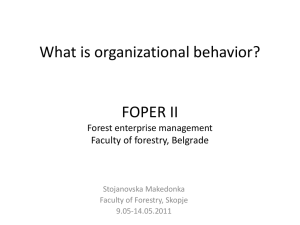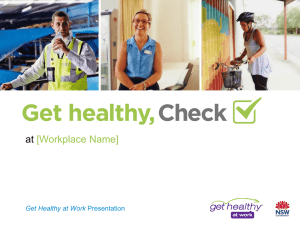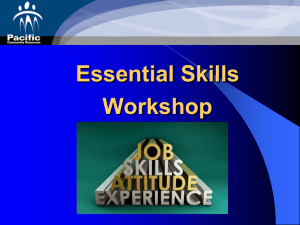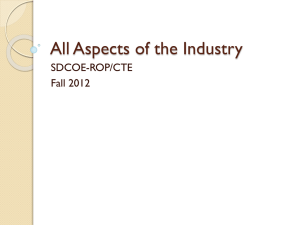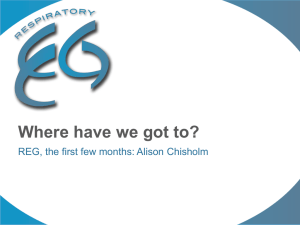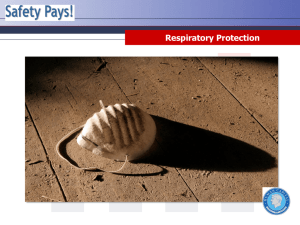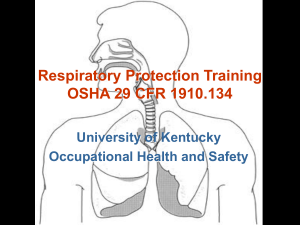Presentation - Public Health Ontario
advertisement
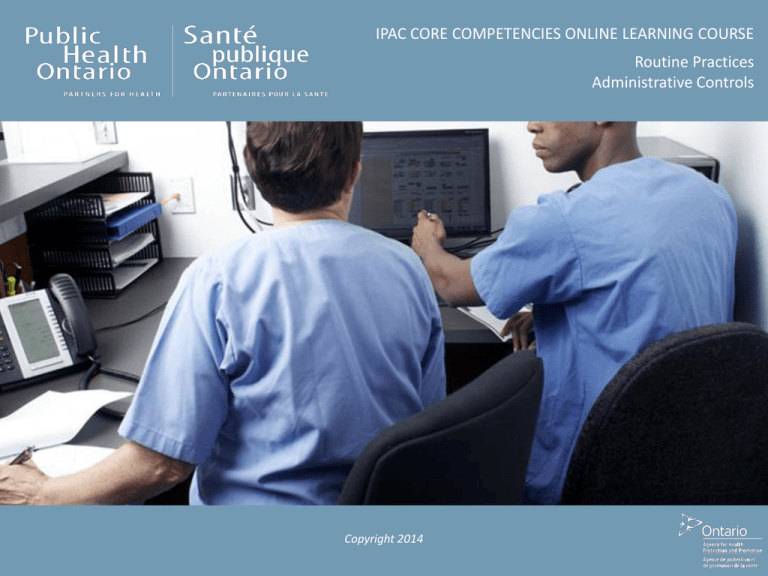
IPAC CORE COMPETENCIES ONLINE LEARNING COURSE Routine Practices Administrative Controls Copyright 2014 General Introduction to Routine Practices Routine Practices are infection prevention and control practices that are: - Used routinely during all activities - Used for all clients, patients and residents - Used in all health care settings to help prevent and control the spread of infectious agents. OVERVIEW An important element of Routine Practices is Administrative Controls. In this component, you will learn about: • how Administrative Controls help protect health care providers and clients/patients/residents from infection • the effectiveness of Administrative Controls depends on their consistent implementation by management and health care providers OVERVIEW Objectives: After finishing this component, you will be able to: identify Administrative Controls in the health care setting describe and apply Administrative Controls to prevent and control infection in your health care setting OVERVIEW Introduction Administrative Controls are measures that the administration of a health care setting puts into place to help protect health care providers and clients/patients/residents from infection. Administrative Controls include: • • infection prevention and control policies and procedures healthy workplace policies • health care provider education • education of clients/patients/re sidents • healthy workplace initiatives POLICIES & PROCEDURES Policies and procedures for infection prevention and control must be: • evidence-based and consistent with legislation and standards • established by the employer to guide safe care and practices • relevant to the health care setting and accessible • followed by all health care providers • reviewed and updated on a regular basis • communicated to health care providers through training • developed in conjunction with Infection Prevention and Control, Occupational Health and Safety and the Joint Health and Safety Committee. INFECTION PREVENTION AND CONTROL EDUCATION AND TRAINING Infection prevention and control education and training needs to be part of orientation and ongoing scheduled education for health care providers. INFECTION PREVENTION AND CONTROL EDUCATION AND TRAINING Employers should provide training on Routine Practices and Additional Precautions, which includes: chain of transmission the use of personal protective equipment (PPE) hand hygiene cleaning and disinfection risk assessment healthy workplace policies Discussion What educational sessions related to infection prevention and control have you attended in the last year? INFECTION PREVENTION AND CONTROL EDUCATION AND TRAINING Client/patient/resident teaching should include: when and how to do hand hygiene cover your cough not sharing personal items infection prevention and control precautions and practices Discussion What materials are available to help your clients/patients/residents learn about how to protect themselves from infection? HEALTHY WORKPLACE - POLICIES Healthy workplace policies include: work exclusion visitor restriction immunization HEALTHY WORKPLACE – WORK EXLUSION A health care provider work exclusion policy needs to include: work exclusion • directions about not working when ill with a potentially communicable disease • education for health care providers about: self-screening for signs and symptoms of communicable diseases reporting an illness returning to work after an illness HEALTHY WORKPLACE – VISITOR RESTRICTION Health care providers should: visitor restriction • be alert to visitors with symptoms of an infection and provide direction and education about the risks of transmitting infection • advise family members and visitors to postpone their visit if they are ill with symptoms of an infection HEALTHY WORKPLACE – IMMUNIZATION POLICIES "Immunization is one of the most effective ways to protect clients/patients/residents and health care providers from getting vaccinepreventable diseases." - Provincial Infectious Diseases Advisory Committee (PIDAC) immunization policies HEALTHY WORKPLACE – IMMUNIZATION PROGRAMS Health care providers should: • have up-to-date immunizations or evidence of immunity • receive annual influenza immunization • have appropriate immunizations for the type of work they will be doing • know how to access immunizations Discussion What immunizations do you need to protect yourself and your clients/patients/residents, and where will you receive those immunizations? HEALTHY WORKPLACE – OCCUPATIONAL HEALTH AND HYGIENE Occupational health and hygiene includes: restricting where food and drinks may be consumed a respiratory protection programs respiratory etiquette a sharps injury prevention program HEALTHY WORKPLACE – EATING AND DRINKING Health care providers who consume food or beverages in care areas are at increased risk of acquiring gastrointestinal infections with vomiting and diarrhea. restricting where food and drinks may be consumed HEALTHY WORKPLACE – RESPIRATORY PROTECTION PROGRAM A respiratory protection program is required for staff members that will be required to wear an N95 respirator (Ministry of Labour requirement). a respiratory protection programs A respiratory protection program includes: • a health assessment • N95 respirator fit-testing, according to Canadian Standards Association (CSA) standards • training in the use of an N95 respirator HEALTHY WORKPLACE – RESPIRATORY PROTECTION PROGRAM Health care providers should: a respiratory protection programs • be fit-tested and trained in the use of an N95 respirator (every 2 years) • use the type and size of respirator for which they have been fitted • perform a “seal check” each time they wear a fit-tested respirator • be assessed by Occupational Health for alternative protection if they cannot wear an N95 respirator Discussion In your health care setting, how would you get respirator fit-testing and training? HEALTHY WORKPLACE – RESPIRATORY ETIQUETTE Respiratory etiquette: • is a set of personal practices for health care providers and clients/patients/resident to use when coughing or sneezing • helps prevent the spread of bacteria and viruses that cause acute respiratory infections respiratory etiquette HEALTHY WORKPLACE – RESPIRATORY PROTECTION STRATEGIES Respiratory protection strategies: • turn your head away from others when coughing or sneezing • keep a 2-metre separation between you and others when coughing or sneezing • cover your nose and mouth with tissue and then dispose of tissues into waste immediately after use • clean your hands immediately after disposal of tissues • provide masks for coughing clients, patients or residents HEALTHY WORKPLACE – RESPIRATORY PROTECTION STRATEGIES Respiratory protection strategies: • turn your head away from others when coughing or sneezing • keep a 2-metre separation between you and others when coughing or sneezing • cover your nose and mouth with tissue and then dispose of tissues into waste immediately after use • clean your hands immediately after disposal of tissues • provide masks for coughing clients, patients or residents HEALTHY WORKPLACE – RESPIRATORY PROTECTION STRATEGIES Respiratory protection strategies: • turn your head away from others when coughing or sneezing • keep a 2-metre separation between you and others when coughing or sneezing • cover your nose and mouth with tissue and then dispose of tissues into waste immediately after use • clean your hands immediately after disposal of tissues • provide masks for coughing clients, patients or residents HEALTHY WORKPLACE – RESPIRATORY PROTECTION STRATEGIES Respiratory protection strategies: • turn your head away from others when coughing or sneezing • keep a 2-metre separation between you and others when coughing or sneezing • cover your nose and mouth with tissue and then dispose of tissues into waste immediately after use • clean your hands immediately after disposal of tissues • provide masks for coughing clients, patients or residents HEALTHY WORKPLACE – RESPIRATORY PROTECTION STRATEGIES Respiratory protection strategies: • turn your head away from others when coughing or sneezing • keep a 2-metre separation between you and others when coughing or sneezing • cover your nose and mouth with tissue and then dispose of tissues into waste immediately after use • clean your hands immediately after disposal of tissues • provide masks for coughing clients, patients or residents HEALTHY WORKPLACE – SHARPS HANDLING Handling sharps safely is essential! Sharps are objects capable of causing punctures or cuts. A sharps injury prevention program must be in place in all health care settings. a sharps injury prevention program HEALTHY WORKPLACE – SHARPS HANDLING Health care providers must: have training and education on the proper use of needles and other sharp objects use a punctureresistant sharps container at pointof-care routinely use safetyengineered needles not fill a sharps container beyond the “fill” line HEALTHY WORKPLACE – OCCUPATIONAL HEALTH AND HYGIENE If a safety-engineered sharp is not available: never recap a needle never pick up a sharp with bare hands always use tongs to pick up a sharp, or sweep up a sharp Know the procedures to follow in case of sharps injury. Discussion How do you handle sharps in your health care setting? MONITORING OF COMPLIANCE WITH FEEDBACK Monitoring of infection prevention and control programs and activities include: • audits to identify areas for improvement • ongoing assessment • feedback and evaluation SUMMARY Administrative Controls: • are managerial measures (such as effective policies and procedures) put in place to help reduce the risk of infection to staff or to clients/patients/residents • guide employers and workers in their roles and responsibilities Policies and procedures that reflect evidence-based literature, legislation and best practices need to be in place in all health care settings. They need to be followed by all staff to help keep the workplace safe. Thank you Copyright 2014 35





